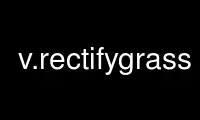
This is the command v.rectifygrass that can be run in the OnWorks free hosting provider using one of our multiple free online workstations such as Ubuntu Online, Fedora Online, Windows online emulator or MAC OS online emulator
PROGRAM:
NAME
v.rectify - Rectifies a vector by computing a coordinate transformation for each object
in the vector based on the control points.
KEYWORDS
vector, rectify
SYNOPSIS
v.rectify
v.rectify --help
v.rectify [-3orb] input=name output=name [group=name] [points=name] [rmsfile=name]
[order=integer] [separator=character] [--overwrite] [--help] [--verbose] [--quiet]
[--ui]
Flags:
-3
Perform 3D transformation
-o
Perform orthogonal 3D transformation
-r
Print RMS errors
Print RMS errors and exit without rectifying the input map
-b
Do not build topology
--overwrite
Allow output files to overwrite existing files
--help
Print usage summary
--verbose
Verbose module output
--quiet
Quiet module output
--ui
Force launching GUI dialog
Parameters:
input=name [required]
Name of input vector map
Or data source for direct OGR access
output=name [required]
Name for output vector map
group=name
Name of input imagery group
points=name
Name of input file with control points
rmsfile=name
Name of output file with RMS errors (if omitted or ’-’ output to stdout
order=integer
Rectification polynomial order (1-3)
Options: 1-3
Default: 1
separator=character
Field separator for RMS report
Special characters: pipe, comma, space, tab, newline
Default: pipe
DESCRIPTION
v.rectify uses control points to calculate a 2D or 3D transformation matrix based on a
first, second, or third order polynomial and then converts x,y(, z) coordinates to
standard map coordinates for each object in the vector map. The result is a vector map
with a transformed coordinate system (i.e., a different coordinate system than before it
was rectified).
The -o flag enforces orthogonal rotation (currently for 3D only) where the axes remain
orthogonal to each other, e.g. a cube with right angles remains a cube with right angles
after transformation. This is not guaranteed even with affine (1st order) 3D
transformation.
Great care should be taken with the placement of Ground Control Points. For 2D
transformation, the control points must not lie on a line, instead 3 of the control points
must form a triangle. For 3D transformation, the control points must not lie on a plane,
instead 4 of the control points must form a triangular pyramid. It is recommended to
investigate RMS errors and deviations of the Ground Control Points prior to
transformation.
2D Ground Control Points can be identified in g.gui.gcp.
3D Ground Control Points must be provided in a text file with the points option. The 3D
format is equivalent to the format for 2D ground control points with an additional third
coordinate:
x y z east north height status
where x, y, z are source coordinates, east, north, height are target coordinates and
status (0 or 1) indicates whether a given point should be used. Numbers must be separated
by space and must use a point (.) as decimal separator.
If no group is given, the rectified vector will be written to the current mapset. If a
group is given and a target has been set for this group with i.target, the rectified
vector will be written to the target location and mapset.
Coordinate transformation and RMSE
The desired order of transformation (1, 2, or 3) is selected with the order option.
v.rectify will calculate the RMSE if the -r flag is given and print out statistcs in
tabular format. The last row gives a summary with the first column holding the number of
active points, followed by average deviations for each dimension and both forward and
backward transformation and finally forward and backward overall RMSE.
2D linear affine transformation (1st order transformation)
x’ = a1 + b1 * x + c1 * y
y’ = a2 + b2 * x + c2 * y
3D linear affine transformation (1st order transformation)
x’ = a1 + b1 * x + c1 * y + d1 * z
y’ = a2 + b2 * x + c2 * y + d2 * z
z’ = a3 + b3 * x + c3 * y + d3 * z The a,b,c,d coefficients are determined by least
squares regression based on the control points entered. This transformation applies
scaling, translation and rotation. It is NOT a general purpose rubber-sheeting, nor is it
ortho-photo rectification using a DEM, not second order polynomial, etc. It can be used if
(1) you have geometrically correct data, and (2) the terrain or camera distortion effect
can be ignored.
Polynomial Transformation Matrix (2nd, 3d order transformation)
v.rectify uses a first, second, or third order transformation matrix to calculate the
registration coefficients. The minimum number of control points required for a 2D
transformation of the selected order (represented by n) is
((n + 1) * (n + 2) / 2) or 3, 6, and 10 respectively. For a 3D transformation of first,
second, or third order, the minimum number of required control points is 4, 10, and 20,
respectively. It is strongly recommended that more than the minimum number of points be
identified to allow for an overly-determined transformation calculation which will
generate the Root Mean Square (RMS) error values for each included point. The polynomial
equations are determined using a modified Gaussian elimination method.
Use v.rectifygrass online using onworks.net services
